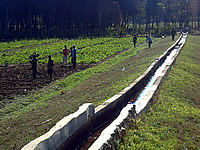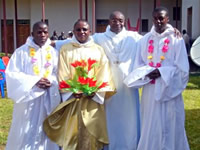|
|
|
|
 |
|
Zambia: Katibunga Monastery Flowers and Orchids
 |
 |
 |
The garden at Katibunga. Many of the local people have started imitating the monks by engaging in agriculture: on a smaller scale, they keep poultry as well as goats and sheep, they grow maize in large quantities and also produce millet, sunflowers, and beans. |
One of ARC's long-term associations has been with Katibunga Priory, a Benedictine monastery founded in 1987 on a former mission site in the remote Chinsali province of northern Zambia.
2010 Update
£2000 raised by ARC helped the Katibunga Monastery prepare three nurseries with 66,000 pine seedlings. They are now preparing eucalyptus seedlings to be planted in time for the rainy season during November, December and January.
Flowers, mangoes and citrus trees are also thriving in the fertile soil of the Monastery grounds.
Katibunga 2009
 |
 |
 |
The monks are teaching local people by demonstrating how to utilize nature without destroying it. |
Here is the latest report from Katibunga, sent by the prior of Katibunga, Fr Willibrord Nzota, in April 2009.
ASSETS: orchards, garden and farmland
"Currently in the monastery, farming has been the first priority - through the garden and also through growing maize, sunflower and beans. We have also the orchards of oranges, tangerines, avocados, bananas and papaws. Also we have fish ponds and a cattle farm.
At the beginning of 2009, we started growing tropical trees (forestation), through which we teach the people to maintain the environment; which has been severely destroyed for a long time by cutting trees for firewood and traditional farming (chitemene). The chitemene system is a traditional farming method which involves cutting a large area of trees. The cut trees are collected together and burned, in order to facilitate growing finger millet and pumpkins.
NOTES:
* One of the original reasons for building a mission at Katibunga is because the soil is excellent.
* The monastery also has a chicken coop for more than 300 chickens.
* The manure from all of the animals is used in the orchard and garden.
* ARC helped fund the creation of orange orchards in the Priory grounds in 2004.
* The monastery provides hydro-electric power for its health centre, for the Katibunga Basic School, for individual homes and for the monastery itself.
* The monastery was one of the key
Education
The monastery is teaching local people by demonstrating how to utilize nature without destroying it. Up to now, we have planted more than 2,500 trees. If funds allow, we intend to grow at least 2000 trees a year.
At the moment, six students from Mkumbi Agricultural College, are at the monastery for one month field attachments. It is the first time this College of Agriculture has sent its students for field attachment to us. Also the Mpika College of Agriculture sends its students for practical learning every January. In this way, through education, farming activities are also beneficial to the people outside Mpika district.
NOTE: The Benedictines have a long history of education, and the monastery at Katibunga has helped in the renovation of the local 500-pupil state school. “The school was in a very bad state. We managed to obtain some funds from a monastery in Switzerland to add two classrooms. We received funds from a monastery in Germany to build two teachers’ houses.”
Pastoral Care
The focus, by the monastery, on agriculatural activities, has led to actual change among the local people. Many local people have started imitating the monks by engaging in agriculture - keeping poultry, goats and sheep, growing millet, sunflower and beans. In this, the monastery has been an inspiration. The monastery also maintains a health centre, for which it also provides hydro-electric power.
Background
Around 28 percent of the Zambian population is Catholic. In 2005 the Zambian bishops made the unusual move of asking for the country’s declaration of itself as a Christian nation to be removed from the constitution. They claimed that such a declaration could lead to abuse of religion for purely political ends and bring discredit to the name “Christian”.
Links
Interview with Fr Willibrord in the Catholic Times
Google Map image of Katibunga
OSB website's hitstory of Katibunga
Monks and Social Services in Katibunga
Picture Gallery
|
 |
|
|
|
|
|

